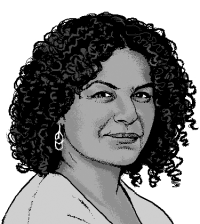October 9, 28th Sunday in Ordinary Time
I’ll never forget the day, decades ago now, when I went snooping in my father’s study. I was four years old and bored, and I soon found myself digging through a tall filing cabinet. In it was a manila folder with four navy blue booklets wrapped in tissue paper. One—I discovered to my delight—had a baby picture of me inside of it, followed by a lot of big words I couldn’t read, followed by several pleasingly blank pages. I couldn’t help myself; I was a doodler. Grabbing a pencil, I sat down at the desk and began to draw.
I don’t know how many minutes passed and how many pages I desecrated before my father walked into the study. “What are you doing?” he cried, snatching the booklet out of my hands and flipping frantically through its pages. It’s only when he set to work erasing my drawings with trembling hands that I realized he was not angry; he was frightened.
Read our latest issue or browse back issues.
“What are those?” I asked him.
“Our passports,” he said, without looking up. “These are our American passports. They prove we belong here. Without them . . .” He didn’t finish the sentence. “Please don’t ever play with these again.”
I didn’t. Even now, years later, I treat my passport gingerly, like an icon or a relic, convinced it might disintegrate in my hands. My father’s old, immigrant fear—the fear of not belonging, of being cast out—lives on.
This week’s Gospel story is, of course, about thankfulness. Ten lepers experience healing; one experiences salvation. There is something about the practice of thankfulness that enlarges, blesses, and restores us. The leper’s act of gratitude points to the fact that we were created to recognize life as a gift and to find our salvation at the feet of the giver.
But this passage also speaks to questions of identity—questions of exclusion and inclusion, exile and return. This is a story about the kingdom of God—about who is welcome, who belongs, and who stays. As a daughter of immigrants, I feel these questions in my bones. They’re not intellectual or abstract; they’re emotional and urgent. What does it mean to belong? Where is home, and what is my identity?
Three years after that day in the study, we took a family trip to India, my parents’ homeland. One morning, as my father was standing in line to buy tickets at a village train station, my little brother pointed to two figures sitting hunched in a corner. “What’s wrong with them?” he asked.
By then we’d been in India for two weeks, and I was accustomed to seeing beggars. Exhausted women with too-thin babies on their hips. Men who were blind or lame. Pot-bellied children who stared at my Western clothes. New to witnessing such relentless need, I spent my days digging in my father’s wallet or my mother’s purse, handing out every bill or coin they’d spare.
But these two figures were different. Though I guessed they needed help, too, I didn’t want to approach them. Their faces were distorted, eaten. Their fingers were half-missing, and their feet were scary, mottled stumps. “They’re sick,” my father answered after a quick, pitying glance in their direction. “They have leprosy.”
The train station was crowded that day, swarming with travelers, vendors, and beggars. But what struck me about those figures huddling in the shadows was how alone they were. It was otherworldly, profound and impenetrable in a way I could barely comprehend. It was as if some invisible barrier, solid as granite, separated them from the rest of humanity, rendering them wholly untouchable. Yes, their disease frightened me. But what frightened me much more was their isolation, their not-belonging.
The lepers in the Gospel story also live in the shadows—in a no-man’s-land, “a region between.” They are required to live in seclusion, keep their distance from passersby, sport torn clothes and disheveled hair, and announce their own contagion with loud, humiliating cries: “Unclean!”
So when Jesus heals their leprosy he does not merely cure their bodies; he restores their identities. He enables their return to all that makes us fully human—family, community, society, intimacy. In healing their withered skin and numbed limbs, he releases them to feel again—to embrace and be embraced, to worship in community, to reclaim all the social and spiritual ties their disease stole from them. Jesus enters a no-man’s-land—a land of no belonging—and hands out ten unblemished passports. He invites ten exiles home.
Seen from this angle, the tenth leper’s response to Jesus resonates differently. Yes, it’s an expression of gratitude. But it’s also the expression of a deeper and truer belonging. The tenth leper is a Samaritan, a “double other” marginalized by both illness and foreignness. By the first century, the enmity between the Jews and the Samaritans was entrenched and old. The two groups disagreed about everything that mattered to them: how to honor God, how to interpret the scriptures, where to worship. They avoided social contact when possible. It’s quite possible that the Samaritan’s social ostracism continues even after the local priests declare him clean.
So what does he do? What does his otherness enable him to see that his nine companions do not? He sees that his identity—his truest place of belonging—lies at Jesus’ feet. He sees that Jesus’ arms are wide enough to embrace all of who he is—leper, foreigner, exile.
Ten lepers dutifully stand at a distance and call Jesus “Master.” One draws close, dares intimacy, and finds his lasting home, clinging to Jesus for a better and more permanent citizenship. The tenth leper moves past obedience and finds friendship. He discovers what happens when duty gives way to love.






